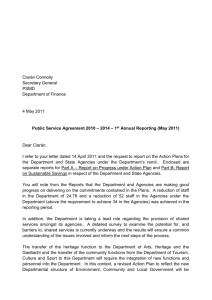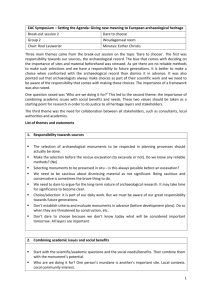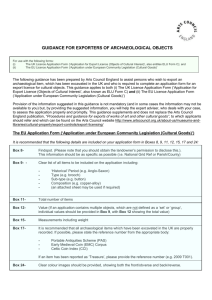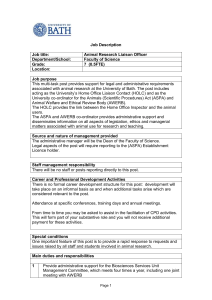NMS 1-06 Excavation Licence Application Form
advertisement
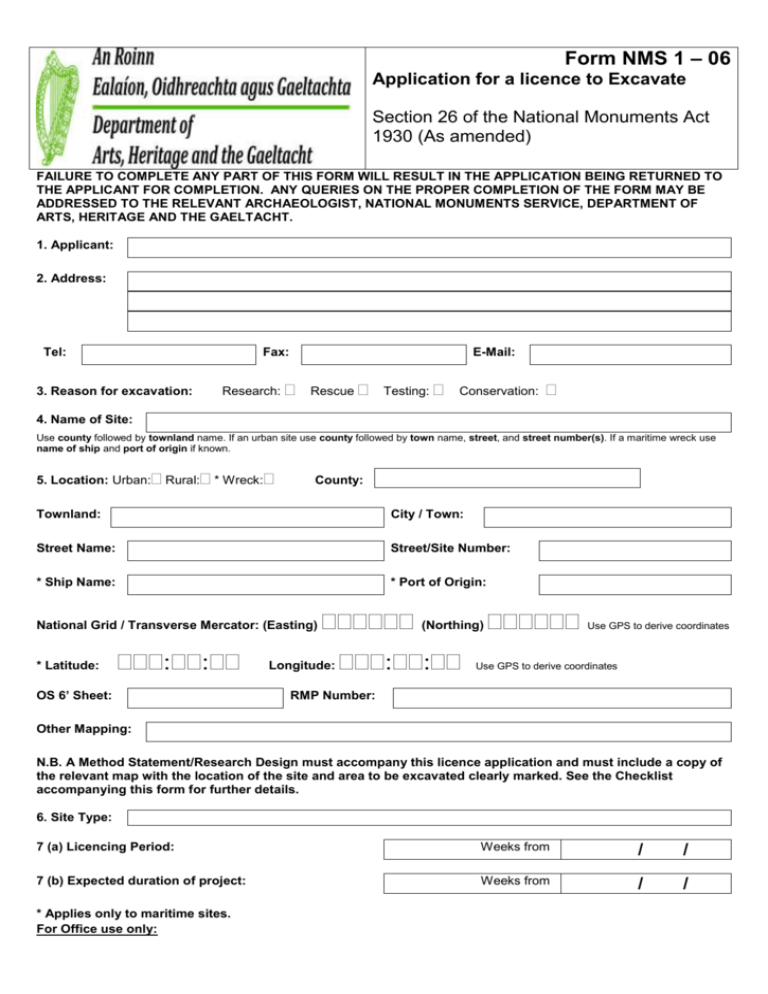
Form NMS 1 – 06 Application for a licence to Excavate Section 26 of the National Monuments Act 1930 (As amended) FAILURE TO COMPLETE ANY PART OF THIS FORM WILL RESULT IN THE APPLICATION BEING RETURNED TO THE APPLICANT FOR COMPLETION. ANY QUERIES ON THE PROPER COMPLETION OF THE FORM MAY BE ADDRESSED TO THE RELEVANT ARCHAEOLOGIST, NATIONAL MONUMENTS SERVICE, DEPARTMENT OF ARTS, HERITAGE AND THE GAELTACHT. 1. Applicant: 2. Address: Tel: Fax: 3. Reason for excavation: E-Mail: Research: Rescue Testing: Conservation: 4. Name of Site: Use county followed by townland name. If an urban site use county followed by town name, street, and street number(s). If a maritime wreck use name of ship and port of origin if known. 5. Location: Urban: Rural: * Wreck: County: Townland: City / Town: Street Name: Street/Site Number: * Ship Name: * Port of Origin: National Grid / Transverse Mercator: (Easting) * Latitude: OS 6’ Sheet: (Northing) Use GPS to derive coordinates Longitude: Use GPS to derive coordinates RMP Number: Other Mapping: N.B. A Method Statement/Research Design must accompany this licence application and must include a copy of the relevant map with the location of the site and area to be excavated clearly marked. See the Checklist accompanying this form for further details. 6. Site Type: 7 (a) Licencing Period: Weeks from / / 7 (b) Expected duration of project: Weeks from / / * Applies only to maritime sites. For Office use only: Application Received: ……/……/…….. Sent to NMI: Response issued: Response NMI: ……/……/……. ……/……/…….. ……/……/……. Form NMS 1 – 06 8. Owner of site: Owners address: 9. Has site been inspected by applicant: Yes: No: 10. Project Funding: (are adequate funds available for the following?) (a) Excavation: (b) Post-Excavation Analysis: (c) Publication: (d) Source of Funding: 11. Planning Details: (to be filled out only if the Licence is in connection with a development) Planning Authority: Planning Register Number: Are you aware of the planning conditions relating to this site?: Yes: No: (if no, please explain in Method Statement) 12. Finds: (a) Where will finds be housed (post-excavation) (b) Where will finds be housed ultimately (c) What facilities are available for conservation (d) Proposed site archive location 13. Publication record: Please attach list of reports divided into the following categories (a) Published Reports, (b) Unpublished reports (state whether lodged with DoAHG or not) Note: The Minister for the Arts, Heritage and the Gaeltacht may in accordance with the provisions of Section 26(2) of the National Monuments Act 1930 (as amended) at his discretion refuse a licence to any applicant where he considers that the application or method statement/research design is incomplete, lacking in sufficient detail or otherwise deemed to be invalid I declare that the above information is accurate and that if the licence is granted I will abide by the conditions set out overleaf. Signature: _________________________________________ Date: _________________________________________ The completed application form, together with a detailed method statement/research design, must be received by the Archaeological Licensing Unit, National Monuments Service, Department of Arts, Heritage and the Gaeltacht, G.50, Custom House, Dublin 1 at least three weeks prior to the date on which it is proposed to commence the project. At the same time a copy of the application should be sent to The Duty Officer, Irish Antiquities Division, National Museum of Ireland, Kildare Street, Dublin 2. The National Museum of Ireland is a statutory consultee in relation to licence applications as specified under the provisions of Section 26(2) of the National Monuments (Amendment) Act 1930 (as amended). Under no circumstances should any excavation work be carried out before an applicant has been notified by the Minister for Arts, Heritage and the Gaeltacht that a licence has been granted to him/her. The carrying out of an unlicensed archaeological excavation is an offence under Section 26(3) of the National Monuments Act 1930 (as amended). It is recommended that all first time applicants should apply for interview to assess their competency to hold a licence. Those applicants wishing to be interviewed should apply to Archaeological Licensing Unit, National Monuments Service, Department of Arts, Heritage and the Gaeltacht, G.50 Custom House, Dublin 1. Conditions relating to Archaeological Excavation Licences granted under the National Monuments Acts (1930-2004) Form NMS 1 - 06 1. The licence holder must obtain permission from the owner of the land/ *wreck to carry out their project and particularly to alter, dig or excavate in or under the site before availing of this licence. No responsibility shall attach to the Minister for Arts, Heritage and the Gaeltacht for failure on the part of the licence holder to obtain such permission. 2. The licence holder shall be responsible for all loss, damage or injury, to persons or property, in any way arising from their project and shall indemnify the State and the Minister for Arts, Heritage and the Gaeltacht, his/her officers, agents and employees against all action, loss, claims, damages, expenses and demands arising therefrom. The licence holder shall restore the land to its original condition on termination of this licence, unless otherwise directed by the Minister or the landowner. 3. The licence holder shall comply in all respects with the provisions of the National Monuments Acts 1930-2004 and any Acts altering, amending or replacing those Acts. Copies of the Acts are available from the Departments website www.archaeology.ie and from Government Publications Office Molesworth Street, Dublin 2. 4. Under the provisions of the National Monuments Acts, all archaeological objects, whose ownership is unknown, are the property of the State. The National Museum of Ireland is the State repository for all such archaeological objects. The National Museum of Ireland shall be consulted by the licence holder in relation to the final disposition/location of any archaeological objects and the temporary storage of finds. Separate licences must be applied for if it is intended to alter, export or destructively sample any artefacts recovered during the project. Applications for these licences should be made to the Director of the National Museum of Ireland. 5. * Finders of wrecks must report any such find within four days, to the National Monuments Service, Department of Arts, Heritage and the Gaeltacht , or to a member of the Garda Siochána, stating their name and address, the nature of the wreck found and the circumstances in which it was found. 6. The licence holder shall be given a reference number in relation to each excavation or part thereof which shall be used in all correspondence relating to the project and for the numbering of finds (if any) recovered during the project. The licence holder shall also comply with the requirements of the National Museum of Ireland as regards to the numbering and care of archaeological objects. 7. The licence holder shall conduct the excavation in accordance with the Method Statement/Research Design as approved in the grant of licence. This licence is a legal document and is based on information given by the applicant. Any variation to the methodology outlined in that document must be approved in advance with the National Monuments Service of the Department of Arts, Heritage and the Gaeltacht . 8. The licence holder, in signing their application, is also agreeing to abide by the Department’s Policy and Guidelines on Archaeological Excavations and any subsequent policies, guidance or advice, issued by, or on behalf of the Minister for Arts, Heritage and the Gaeltacht. 9. The licence holder shall: (a) Lodge a preliminary report on the excavation with the Department of Arts, Heritage and the Gaeltacht and the National Museum of Ireland within four weeks of the completion of the excavation. (b) Lodge a detailed report on the excavation within twelve months of completion with the Department of Arts, Heritage and the Gaeltacht and the National Museum of Ireland. This report should be to publication standard and should include a full account, suitably illustrated, of all archaeological features, finds and stratigraphy along with a discussion and specialist reports. (c) Publish a concise report to a satisfactory standard in the Excavation Bulletin for the year in which the licence is valid. (d) Publish the results of the excavation in a format agreed with the National Monuments Service. The Minister of Arts, Heritage and the Gaeltacht may publish or make generally available in any form, any report, or part thereof, submitted on the results of the excavation. 10. The Minister for Arts, Heritage and the Gaeltacht may revoke this licence at any time should he form the view that the excavation is not being conducted in accordance with the conditions of the licence or is otherwise contrary to the protection of the archaeological built heritage. 11. The licence holder must inform the National Monuments Service at least two working days in advance of the actual commencement of the project. 12. The licence holder must inform the National Monuments Service within two working days of completion of the project. 13. Officers, servants or agents of the Minister for Arts, Heritage and the Gaeltacht may inspect the excavations at any time and the licence holder shall facilitate such inspections. Form NMS 1 - 06 Checklist of material to be included in the Method Statement / Research Design to accompany licence application: 1. Summary: 2. Location: Provide copy of OS map (1:5,000) for rural sites, (1:1,000) for urban sites and/or 6” or RMP maps as appropriate. * In the case of maritime sites, admiralty charts may be more appropriate. Topographical description. Description of site location. Where available, provide survey information, aerial photographs etc. 3. Aims of project: Description of planning history/research objectives. Description of local archaeological context – previous excavations/surveys. Description of archaeological potential of the site/location. 4. Project Strategy: Excavation area described (including cuttings). Method of excavation to be described. 5. Description of development, build method and schedule (where relevant): Include planning condition and explain timescales involved and time restrictions (if any). 6. Constraints on archaeological methods (if applicable): Safety hazards, Piling/Shoring/Access. 7. Project Team: Outline team structure – number of archaeologists/supervisors. Backup measures, logistical support – e.g. details of excavation team on call (if applicable). 8. Finds retrieval strategy: Describe methods / equipment to be used. 9. Conservation: On site facilities, off site facilities, site/monument conservation implications. 10. Specialists: Provide names and addresses. Note: If site likely to produce human remains provide name of osteoarchaeologist to the project. 11. Storage after completion of fieldwork: Where? And under what conditions. 12. Types of report envisaged (and estimated timescales): Preliminary, detailed and publication. 13. Illustrations: OS 6” OS 25”/1:2500 OS 1:1,000 (Urban) OS 1:5,000 (Rural) Site Survey Aerial Photograph Site Layout Layout of cuttings Geophysics Photographs Other * Admiralty Chart

